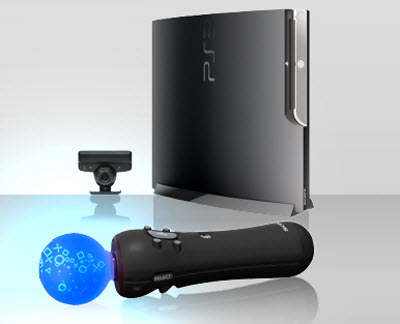
The system for the PlayStation 3 game console uses the existing PlayStation Eye camera to sense the position of a new device, the Sony PlayStation Move controller, which has an LED-lit ball on top of a stick that is shaped like the handle of a sword. The controller has traditional buttons on it, but you can use it to control a game simply by swinging it around because it has motion-sensing technology inside it.
[aditude-amp id="flyingcarpet" targeting='{"env":"staging","page_type":"article","post_id":214520,"post_type":"story","post_chan":"none","tags":null,"ai":false,"category":"none","all_categories":"business,games,","session":"A"}']It costs $99 for a camera and controller bundle, or just $49 for a controller alone; that means a two-player Move system will cost you $150). If you also want a left-hand Move navigation controller (to move with left hand as you are shooting and aiming with the right), you have to pay another $29. If you want to buy a bundle with a PS 3 with a 320-gigabyte hard drive, the Sports Champions game, and one controller/camera, it will cost you $399.
AI Weekly
The must-read newsletter for AI and Big Data industry written by Khari Johnson, Kyle Wiggers, and Seth Colaner.
Included with VentureBeat Insider and VentureBeat VIP memberships.
I predict that Sony is going to sell a lot of these systems to mainstream gamers over time, far more than its mildly successful EyeToy cameras. But I haven’t played a Move game yet that really knocks me for a loop. I’m still waiting to find a killer app, which could be hidden among the dozens of games launching for the Move this fall.
If that killer app doesn’t emerge, then Sony is in for a tough battle, as it is wedged between the Nintendo Wii, which with its Wii MotionPlus add-on has the accuracy of a gyroscope-accelerometer combo, and Microsoft’s Kinect, which uses a 3D-sensing camera to map a physical space and monitor motion in a room.
That’s because the camera depends on sensing the presence and location of the LED-lit ball on top of the Move controller. That allows it to fix the exact location of the controller, at least on a two-dimensional plane. It doesn’t work so well in a bright or a dark room, so you have to adjust your lighting. With an accelerometer, magnetometer (compass), and gyroscope built into it, the Move system can sense where your arm is and what you’re doing with it.
The system works. It’s pretty good at detecting what it needs to in any given game. But you have to calibrate it every time you start a new game. That’s annoying and it means that you can’t jump into a game nearly as fast as you should. Instead of pick-up-and-play, it’s a device where you pick-up, calibrate, and play. You have to make sure you are standing in the right place (within 12 feet of the camera) to be seen properly. And the accuracy is not 100 percent, no matter what Sony says. It’s close to 100 percent, but the misses are annoying.
[aditude-amp id="medium1" targeting='{"env":"staging","page_type":"article","post_id":214520,"post_type":"story","post_chan":"none","tags":null,"ai":false,"category":"none","all_categories":"business,games,","session":"A"}']
The game that held my family’s attention the longest was Sports Champions. The game is a poor rival to Wii Sports, the hit game on Nintendo’s Wii console. My kids told me that flatly. That’s because the game completely lacks any personality its characters, who are drawn with lifelike dimensions but don’t really do anything amusing. They are quite bland compared to the cute and funny Nintendo characters.
The ping-pong game that comes with Sports Champions is also pretty good, but not perfect. You have the same lifeless characters. You can swing your controller and make the paddle move in various directions. But when you serve a ball, you have to move your controller up and then swing it. A lot of the time, you miss. That means it’s not very intuitive to serve a ball. Once the ball is in motion, it’s easier to hit. But you don’t hit the ball exactly the way you expect to do so every time. You can blame that on your own error, or on a lack of precision. Still, it’s accurate enough to get into the game and feel like you’re immersed in a deal with a ping-pong player.
[aditude-amp id="medium2" targeting='{"env":"staging","page_type":"article","post_id":214520,"post_type":"story","post_chan":"none","tags":null,"ai":false,"category":"none","all_categories":"business,games,","session":"A"}']
I think that over time, the game developers will learn how to make games with precise timing that fits with how different kinds of users play the games. But the system and the games are not there yet. Based on my interview with Marks, who showed me many different types of movements that are possible with the Move, I am confident that those games will arrive and that this system will be more successful than the EyeToy, which sold 10 million units.
For now, Sports Champions is a nice introduction to the Move. But Sony has to do a better job of identifying the launch titles that live up to the hype, or get to work on some new titles that will do so. I look forward to playing more Move games, especially shooting games such as Time Crisis. And I look forward to peripherals that can make the Move more accurate or realistic. But Sony hasn’t knocked out either Nintendo or Microsoft as far as I can see.
VentureBeat's mission is to be a digital town square for technical decision-makers to gain knowledge about transformative enterprise technology and transact. Learn More
